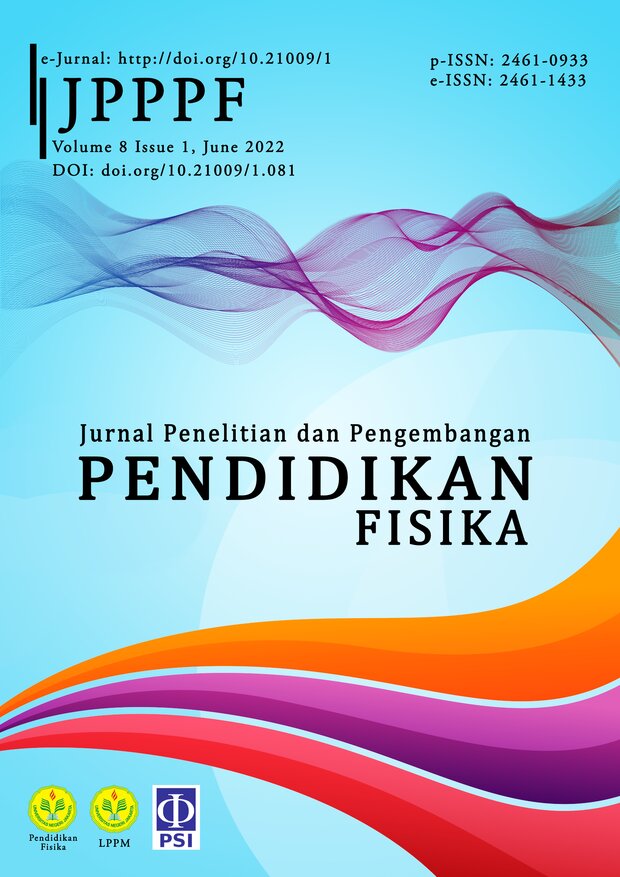Design and Development of College Student Worksheets for Simulation of Electromagnetic Waves
DOI:
https://doi.org/10.21009/1.08101Keywords:
college student worksheet, computational thinking, electromagnetic wavesAbstract
Many studies show that student worksheets can be suitable teaching materials to achieve learning objectives, whether at school or college. Also, college student worksheets can make it easier for students to learn computing-based lessons. This study aims to design and develop worksheets and integrate them with computational thinking (CT) skills in computer programming courses. The material intended to be used as a worksheet is how to simulate electromagnetic waves (EM). This worksheet is also designed with group activities and is expected to improve collaboration skills between college students. This study uses research and development (R&D) methods with the 4D model approach but does not do the fourth stage, dissemination. The worksheet developed has six main elements: (1) titles, (2) study guides, (3) essential competencies, (4) subject matter or supporting information, (5) tasks or work steps, and (6) student assessments. The resulting worksheet products have also been assessed by peers and declared worthy as teaching materials. In addition, the resulting worksheet has shown the steps in CT, namely, abstraction, algorithm, and generalization.
References
Atmatzidou, S & Demetriadis, S 2016, ‘Advancing students ’ computational thinking skills through educational robotics : A study on age and gender relevant differences’, Robotics and Autonomous Systems, vol. 75, pp. 661-670.
Bakri, F, Permana, H, Wulandari, S & Muliyati, D 2020, ‘Student worksheet with ar videos: Physics learning media in laboratory for senior high school students’, Journal of Technology and Science Education, vol. 10, no. 2, pp. 231-240.
Bakri, F, Sumardani, D & Muliyati, D 2019, ‘Integrating augmented reality into worksheets: Unveil learning to support higher-order thinking skills’, AIP Conference Proceedings, vol. 2169, p. 020012.
Frigerio, D, Richter, A, Per, E, Pruse, B & Vohland, K 2021, ‘Citizen Science in the Natural Sciences’, In: Vohland K. et al. (eds) The Science of Citizen Science, Springer, Cham.
Griffiths, DJ 1999, ‘Introduction to electrodynamics (Third ed.)’, Prentice Hall, pp. 559-562.
Gurl, TJ, Fox, R, Dabovic, N & Leavitt, AE 2016, ‘Planning Questions and Persevering in the Practices’, National Council of Teachers of Mathematics, The Mathematics Teacher, vol. 110, no. 1, pp. 33-39.
Hsu, T, Chang, S & Hung, Y 2018, ‘How to learn and how to teach computational thinking : Suggestions based on a review of the literature’, Computers & Education, vol. 126, pp. 296-310.
Hussey, T & Smith, P 2010, ‘The uses of learning outcomes’, Teaching in Higher Education, vol. 8, no. 3, pp. 357-368.
Jylkkä, J & Railo, H 2019, ‘Consciousness as a concrete physical phenomenon’, Consciousness and Cognition, vol. 74, p. 102779.
Khasanah, AN, Sajidan, S & Widoretno, S 2017, ‘Efectiveness of critical thinking indicator-based module in empowering student’s learning outcome in respiratory system study material’, Jurnal Pendidikan IPA Indonesia, vol. 6, no. 1, pp. 187-195.
Lin, S, Chien, S, Hsiao, C, Hsia, C & Chao, K 2020, ‘Enhancing computational thinking capability of preschool children by game-based smart toys’, Electronic Commerce Research and Applications, vol. 44, p. 101011.
Muliyati, D, Sumardani, D, Siswoyo, S, Bakri, F, Permana, H, Handoko, E & Sari, Ni 2021, ‘Development and evaluation of granular simulation for integrating computational thinking into computational physics courses’, Education and Information Technologies. pp. 1-28.
Nasrullah, A, Marlina, M & Dwiyanti, W 2018, ‘Development of Student Worksheet-Based College E-Learning Through Edmodo to Maximize the Results of Learning and Motivation in Economic Mathematics Learning’, International Journal of Emerging Technologies in Learning (iJET), vol. 13, no. 12, pp. 211-229.
Plevris, V & Tsiatas, GC 2018, ‘Computational Structural Engineering: Past Achievements and Future Challenges’, Frontiers in Built Environment, vol. 4, p. 21.
Rufaida, D, Sudarmin, L & Widiyatmoko, A 2013, ‘Development of Microsoft Expression Web-assisted IPA LKS’, Unnes Science Education Journal (USEJ), vol. 2, no. 1, pp. 209-216.
Russo, J, Hopkins, S 2017, ‘Student reflections on learning with challenging tasks: ‘I think the worksheets were just for practice, and the challenges were for maths’, Math Ed Res J, vol. 29, pp. 283-311.
Tang, X, Yin, Y, Lin, Q, Hadad, R & Zhai, X 2020, ‘Assessing computational thinking: A systematic review of empirical studies’, Computers & Education, vol. 148, p. 103798.
Trinh-Xuan, D, Bradley, PJ, Brennan, C 2012, ‘Fast Fourier Transform Based Iterative Method for Electromagnetic Scattering From 1D Flat Surfaces’, IEEE Transactions on Antennas and Propagation, vol. 60, pp. 5464-5467.
Waiyakoon, S, Khlaisang, J & Koraneekij, P 2015, ‘Development of an instructional learning object design model for tablets using game-based learning with scafolding to enhance mathematical concepts for mathematic learning disability students’, Procedia - Social and Behavioral Sciences, vol. 174, pp. 1489-1496.
Yulkifi, Y, Ningrum, MV & Indrasari, W 2019, ‘The validity of student worksheet using inquiry based learning model with science process skill approach for physics learning of high school’, Jurnal Penelitian & Pengembangan Pendidikan Fisika, vol. 5, no. 2, pp. 155-162.











